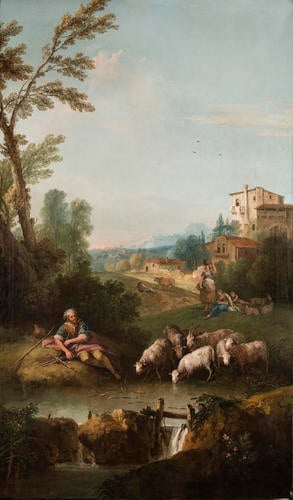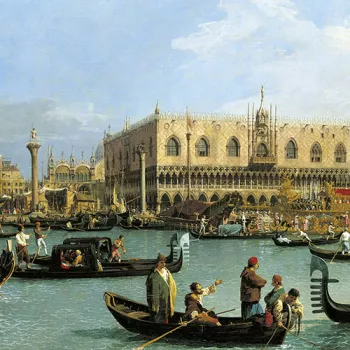Landscape with Jacob Watering Laban's Flock 1743
Oil on canvas | 231.5 x 137.5 cm (support, canvas/panel/stretcher external) | RCIN 406008
-
This painting, along with Jacob and Leah with their Sons (RCIN 406009), is part of a set of six of the same size and format, which Consul Joseph Smith must have commissioned to decorate a specific room. The series illustrates the story of Jacob's sojourn with Laban in Haran (Genesis 29–31), his service to Laban for Jacob's daughters Leah and Rachel, and his desire to return to Canaan.
Landscape with Jacob Watering Laban's Flock, signed and dated 1743, is the only one with a clearly identifiable subject. Jacob wished to leave Laban and return to Canaan with his share of Laban's flock. Laban agreed that he could take all the more unusual striped and speckled animals. It was believed that female animals were influenced by what they saw when conceiving, which affected their offspring. Here Jacob reclines on a bank, having peeled rods to expose white streaks and set them in the water where the flocks come to drink. The biblical text recounts that many striped and speckled animals resulted, so Jacob's flock soon outstripped Laban's. The women in the background are probably Jacob's wives, Leah and Rachel.
The subjects of the other five paintings in the set are less easy to identify. The 'Italian List' does not clarify matters, wrongly describing them as 'landscapes representing the story of Rebecca with Jacob and Esau'. A subsequent, larger, painting on the list, Wooded Landscape with the Meeting of Isaac and Rebecca, is also dated 1743 and is of the same height as the Jacob set, so is therefore likely to have been part of the same decorative scheme. On the basis of Visentini's drawings of Smith's villa at Mogliano, it has been suggested that Smith had a central two-storey room on the upper floor, into which space the six vertical canvases and the large Isaac and Rebecca painting would have fitted neatly. There are some clues to their original arrangement: they divide into pairs, with trees in the left or right foreground; the exception is RCIN 405938, composed for a central position.
The six vertical landscapes are more decorative and have less narrative than the large painting, which is more serious in tone. Here the clothes are appropriate to an Old Testament painting, whereas in the six landscapes they seem only vaguely biblical, with some of the women wearing sandals and more exotically dressed than Zuccarelli's usual peasant women. Jacob fathered 12 sons, who later established the 12 tribes of Israel. The landscapes feature women and children and suggest fertility, the benevolence
of nature and a sense of place – Jacob longs to return home.
The series would have matched the Old Testament set by Sebastiano Ricci in Smith's villa in Venice. Neither Smith nor Zuccarelli were concerned with accurately depicting the story of Jacob in the six landscapes, nor with including the earlier story of Isaac and Rebecca. They are grand and sedate compared with Zuccarelli's other work: the compositions are carefully balanced, the recession in space clearly defined in sections. His technique here is comparable to his smaller paintings, but on a more monumental scale. Nevertheless, the paintings, appropriately for a country villa, are lightly idyllic, the effect graceful and languid – and very much part of the universal and idealised world that Zuccarelli had created.
The painting appears in Pyne's illustrated Royal Residences of 1819, hanging in the Queen's Drawing Room at Windsor Castle (RCIN 922102).
Text adapted from Canaletto & the Art of Venice, 2017.Provenance
Acquired in 1762 by George III from Joseph Smith, British Consul in Venice (Italian List nos 151-6); recorded in the Queen's Bedchamber at Windsor Castle in 1792
-
Medium and techniques
Oil on canvas
Measurements
231.5 x 137.5 cm (support, canvas/panel/stretcher external)
245.0 cm (including paint surface turned back)
272.5 x 179.0 x 12.5 cm (frame, external)
Category
Object type(s)
Subject(s)









